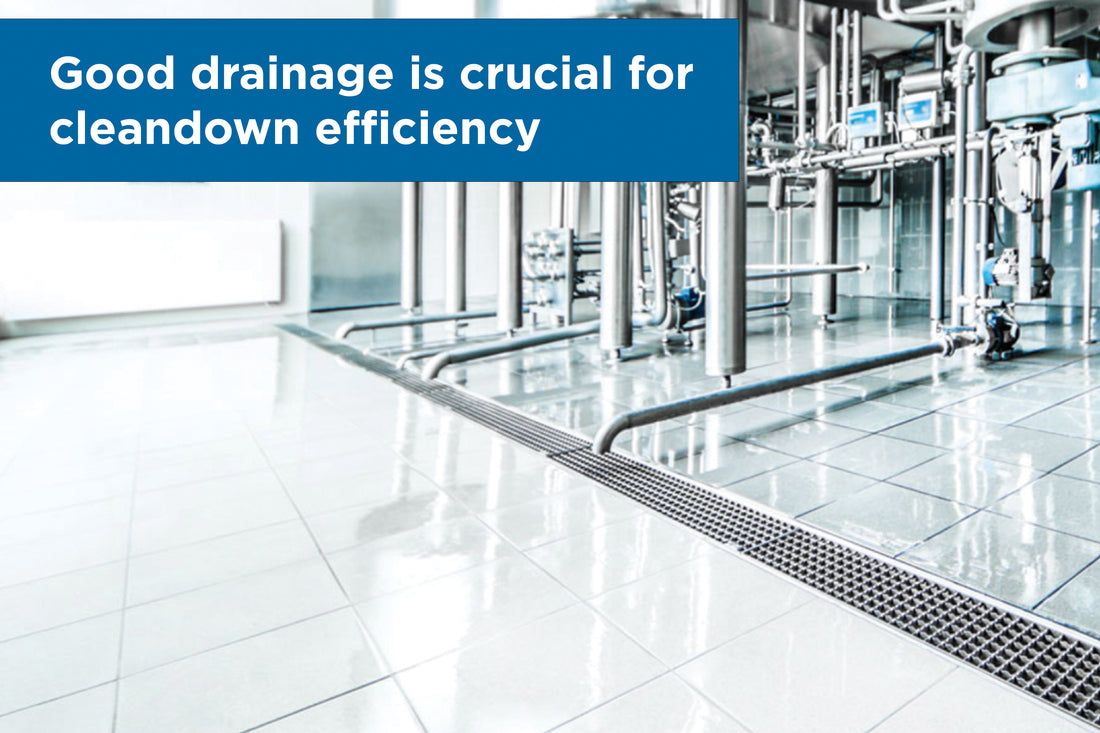We can all agree that it’s better to get it right the first time rather than make changes later down the line… and the same can be said for drainage. Purchasing the wrong drainage system for your hygienic environment is not only a costly mistake, but it can also impact the efficiency of your clean down process. Investing in good drainage is particularly crucial for the food and pharmaceutical sector due to it directly impacting operations, product safety, and regulatory compliance.
Why is it worth investing in good drainage?
Poor drainage can lead to the accumulation of water and waste, which can become breeding grounds for bacteria, mould, and other pathogens. These contaminants can easily compromise the safety and quality of food and pharmaceutical products as well as increase the chance of cross-contamination.
Good drainage is a standard requirement of health and safety regulations and, without it, you may not pass your next audit. The BRCGS clause 4.4.3 states that “drainage, where provided, shall be sited, designed and maintained to minimise risk of product contamination and not compromise product safety.” A lack of an adequate system can cause disruptions and may lead to costly fines, reduced production time, or even site shutdowns.
When is it time to replace your drainage system?
If your drainage channels are old, damaged or in a non-hygienic material, then it’s time for an upgrade! Not only could these issues cause contamination, leading to a failed audit, but also lead to structural damage. You should also look out for any signs of the floor warping or sinking near the drains as this might indicate that the drainage system is failing beneath the surface.
Another indication that it’s time to upgrade is if you have changed your flow requirements. Slow drainage or pooling wastewater suggests that the drainage system is not effectively channelling water away, indicating a capacity issue. If your facility has expanded or if the volume of wastewater has increased, then the existing system may be overwhelmed, requiring an upgrade or replacement.
Explore easy to install ACO Hygiene First drainage kits
We’ve partnered with the drainage experts at ACO to offer their innovative Hygiene First drainage products as ready to install kits. This product range features a hygienically optimised design that keeps food production facilities and pharmaceutical cleanrooms in mind. These kits are engineered to prevent contamination and optimise cleaning efficiency while addressing common concerns such as bacterial growth and stagnant wastewater.
The Hygiene First range is constructed from 304L-grade pickle passivated stainless steel for durability and corrosion resistance during the cleaning process. Featuring smooth contours and the removal of crevices, the range eliminates any potential dirt traps. Designed with hygiene regulations in mind, our drainage and gully kits are compliant with BS EN 1672 and BS ISO 14159 while the drainage channels are also compliant to EHEDG. This includes an internal 3mm radii for easy and effective cleaning as well as a removable stainless steel foul air trap and silt basket.
Most importantly, these drainage and gully kits come in a variety of sizes and configurations with the choice of vertical or horizontal orientation. We also offer different body diameters (157mm and 218mm) and lengths (630mm or 1530mm)
Watch the video on our Hygiene First range.
Tailored drainage solutions using the ACO Modular 125+ range
Our Modular 125+ drainage and gully range allows you to create a custom set up that is BS EN 1433 compliant. The 304L-grade stainless steel channels can be adapted to different floor types including tiled, concrete, and epoxy resin floors. An additional seal can be purchased for vinyl and flexible sheet flooring which also provides suitability for load classes of A15 to C250. This adaptability makes the Modular 125+ system suitable for a wide range of environments.

As part of the ACO Modular 125+ range, we offer channels with both level and sloping inverts in various lengths (from 500mm to 3000mm) and depths (ranging from 50mm to 125mm). This modular approach allows for flexibility during installation and planning, making it easy to integrate the drainage system into existing floor layouts around machinery or other obstacles.
Consider how furniture and equipment impacts drainage capabilities
If you are looking to enhance your drainage system for a quicker and more efficient clean down process, then it is worth considering the furniture and equipment you choose. Many of our products feature hygienic design aspects, such as sloping tops and pre-drilled drainage holes, to prevent water pooling and reduce the chance of contamination. A good example of this is our variety of mesh, slatted and louvered shelving which can easily be hosed down if needed. Many of our stainless steel cupboards also have removable shelves to create added accessibility and support for hygiene regimes.




